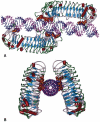Efficacy of rintatolimod in the treatment of chronic fatigue syndrome/myalgic encephalomyelitis (CFS/ME)
- PMID: 27045557
- PMCID: PMC4917909
- DOI: 10.1586/17512433.2016.1172960
Efficacy of rintatolimod in the treatment of chronic fatigue syndrome/myalgic encephalomyelitis (CFS/ME)
Abstract
Chronic fatigue syndrome/ Myalgic encephalomyelitis (CFS/ME) is a poorly understood seriously debilitating disorder in which disabling fatigue is an universal symptom in combination with a variety of variable symptoms. The only drug in advanced clinical development is rintatolimod, a mismatched double stranded polymer of RNA (dsRNA). Rintatolimod is a restricted Toll-Like Receptor 3 (TLR3) agonist lacking activation of other primary cellular inducers of innate immunity (e.g.- cytosolic helicases). Rintatolimod also activates interferon induced proteins that require dsRNA for activity (e.g.- 2'-5' adenylate synthetase, protein kinase R). Rintatolimod has achieved statistically significant improvements in primary endpoints in Phase II and Phase III double-blind, randomized, placebo-controlled clinical trials with a generally well tolerated safety profile and supported by open-label trials in the United States and Europe. The chemistry, mechanism of action, clinical trial data, and current regulatory status of rintatolimod for CFS/ME including current evidence for etiology of the syndrome are reviewed.
Keywords: Ampligen; Rintatolimod; TLR3 agonist; chronic fatigue/myalgic encephalomyelitis; clinical efficacy; clinical safety; clinical trials; dsRNA; primate/non-primate disassociation of toxicity.
Figures





Similar articles
-
Effect of disease duration in a randomized Phase III trial of rintatolimod, an immune modulator for Myalgic Encephalomyelitis/Chronic Fatigue Syndrome.PLoS One. 2020 Oct 29;15(10):e0240403. doi: 10.1371/journal.pone.0240403. eCollection 2020. PLoS One. 2020. PMID: 33119613 Free PMC article. Clinical Trial.
-
A double-blind, placebo-controlled, randomized, clinical trial of the TLR-3 agonist rintatolimod in severe cases of chronic fatigue syndrome.PLoS One. 2012;7(3):e31334. doi: 10.1371/journal.pone.0031334. Epub 2012 Mar 14. PLoS One. 2012. PMID: 22431963 Free PMC article. Clinical Trial.
-
Mismatched double-stranded RNA: polyI:polyC12U.Drugs R D. 2004;5(5):297-304. doi: 10.2165/00126839-200405050-00006. Drugs R D. 2004. PMID: 15357629 Free PMC article.
-
TLR3 agonists as immunotherapeutic agents.Immunotherapy. 2010 Mar;2(2):137-40. doi: 10.2217/imt.10.8. Immunotherapy. 2010. PMID: 20635920 Review. No abstract available.
-
Treatment and management of chronic fatigue syndrome/myalgic encephalomyelitis: all roads lead to Rome.Br J Pharmacol. 2017 Mar;174(5):345-369. doi: 10.1111/bph.13702. Epub 2017 Feb 1. Br J Pharmacol. 2017. PMID: 28052319 Free PMC article. Review.
Cited by
-
Investigational antiviral drugs for the treatment of COVID-19 patients.Arch Virol. 2022 Mar;167(3):751-805. doi: 10.1007/s00705-022-05368-z. Epub 2022 Feb 9. Arch Virol. 2022. PMID: 35138438 Review.
-
Effect of disease duration in a randomized Phase III trial of rintatolimod, an immune modulator for Myalgic Encephalomyelitis/Chronic Fatigue Syndrome.PLoS One. 2020 Oct 29;15(10):e0240403. doi: 10.1371/journal.pone.0240403. eCollection 2020. PLoS One. 2020. PMID: 33119613 Free PMC article. Clinical Trial.
-
RNA-mediated immunotherapy regulating tumor immune microenvironment: next wave of cancer therapeutics.Mol Cancer. 2022 Feb 21;21(1):58. doi: 10.1186/s12943-022-01528-6. Mol Cancer. 2022. PMID: 35189921 Free PMC article. Review.
-
Immunological profiling in long COVID: overall low grade inflammation and T-lymphocyte senescence and increased monocyte activation correlating with increasing fatigue severity.Front Immunol. 2023 Oct 10;14:1254899. doi: 10.3389/fimmu.2023.1254899. eCollection 2023. Front Immunol. 2023. PMID: 37881427 Free PMC article.
-
Myalgic Encephalomyelitis/Chronic Fatigue Syndrome: the biology of a neglected disease.Front Immunol. 2024 Jun 3;15:1386607. doi: 10.3389/fimmu.2024.1386607. eCollection 2024. Front Immunol. 2024. PMID: 38887284 Free PMC article. Review.
References
-
- Johnston S, Brenu EW, Staines DR. The adoption of chronic fatigue syndrome/myalgic encephalomyelitis case definitions to assess prevalence: a systematic review. Ann Epidemiol. 2013;23:371–376. - PubMed
-
- Jason LA, Corradi K, Gress S. Causes of death among patients with chronic fatigue syndrome. Health Care Women Int. 2006;27:615–626. - PubMed
-
- Komaroff AL, Buchwald DS. Chronic fatigue syndrome: an update. Annu Rev Med. 1998;49:1–13. - PubMed
-
- Komaroff AL. Is human herpesvirus-6 a trigger for chronic fatigue syndrome? J Clin Virol. 2006;37(Suppl 1):S39–S46. - PubMed
Publication types
MeSH terms
Substances
LinkOut - more resources
Full Text Sources
Other Literature Sources
Medical
